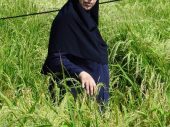 “The RRII plays a leading role in the country scale in the discovery of pure and applied research findings and exploring the pathways to affect outcomes for development through new scientific innovations. Also, RRII, as a responsible center of rice research and innovation continuously focuses on pure and applied researches to fulfill the current needs of farmers. RRII deploys a powerful array of tools to maximize the resource-use efficiency of rice-based farms and reduce the ecological footprints of rice. In 2020, we have made this happen through our Research for-Development (R4D) agenda in five key areas: Climate Change, Varietal mass purification, Effective new rice varieties, and Nutrition and Food Security”. Dr. Maryam Hosseini Chaleshtori, Director General of Rice Research Institute of Iran.
“The RRII plays a leading role in the country scale in the discovery of pure and applied research findings and exploring the pathways to affect outcomes for development through new scientific innovations. Also, RRII, as a responsible center of rice research and innovation continuously focuses on pure and applied researches to fulfill the current needs of farmers. RRII deploys a powerful array of tools to maximize the resource-use efficiency of rice-based farms and reduce the ecological footprints of rice. In 2020, we have made this happen through our Research for-Development (R4D) agenda in five key areas: Climate Change, Varietal mass purification, Effective new rice varieties, and Nutrition and Food Security”. Dr. Maryam Hosseini Chaleshtori, Director General of Rice Research Institute of Iran.
She added that the most important constraints of the rice sector have been met by local farmer were: Low yield of common local varieties (particularly, Hashemi), sensitivity to lodging, high plant
height, the sensitivity of local varieties to drought stress, and a lower percentage of labeled of rice seed compare to the world standard.
“This year, by engaging more deeply with the public and private sectors, we connected the different actors (Agricultural Engineers Organization of Basij and Jihad- Agriculture Organization of Guilan Province) to enable us to bring transformative technologies to farmers’ fields faster. Case in point, with our partners, we made brilliant progress in rice production with 400 agricultural engineers, 12000 farmers at 600 villages through Optimization of Rice Production Program”, she said.

The most important achievements of the rice research institute of Iran were: introducing and releasing of high quality, higher yield, lodging tolerance and dwarf, and drought stress tolerance rice varieties. Moreover, to overcome pure seed limitation and water scarcity, the RRII increased the foundation seeds of rice(Elite)four times (Elite) by about four times and fully finished the national direct seeding program through varietal screening, national direct seeding research projects, and technical bulletins.
She also pointed out that by increasing of certified seeds and mass purification of local rice variety, Hashemi, around 67500 hectares of paddy fields were covered by Hashemi certified seeds. Higher yield, higher price, lower seed consumption, and production costs were the direct benefits of this project.
Anam, Guilaneh, Rash, and Tisa, the newly released rice varieties, noticeably increased the penetration coefficient of high yielding rice varieties across the paddy fields of the north of Iran by about 76.39% of total rice yield and 63.33% of cultivated land compare to 2018 (43.26%, 5.14%).
At the national level collaborations with other research institutions, the RRII started using smart technologies to observe rice paddy field environmental data with the private company; monitoring heavy metal contamination and pesticide residues with the soil and water, and crop production institutions, respectively. Also, at the international level, RRII Started working on perennial rice with the collaboration of the Yunnan University of China.

